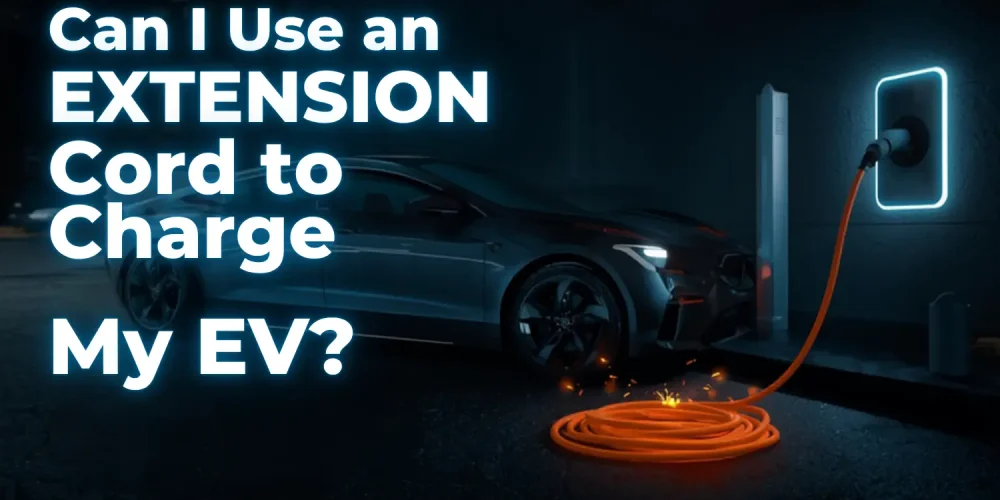
A practical guide to when an extension cord for EV chargers can be used — and when it absolutely shouldn’t.
So, your new electric vehicle is finally home, parked in the driveway. You go to plug in the charging cable… and it does not quite reach the outlet. The immediate thought, of course, is to grab that standard orange or white extension cord from your garage. But is this safe?

Straight answer, No! Using a typical household cord is a significant, documented safety hazard. However, there are a few options you could consider as a temporary, last-resort solution.
Let’s break it down…
1. The “Why Not?”: Understanding the Dangers of a Standard Cord
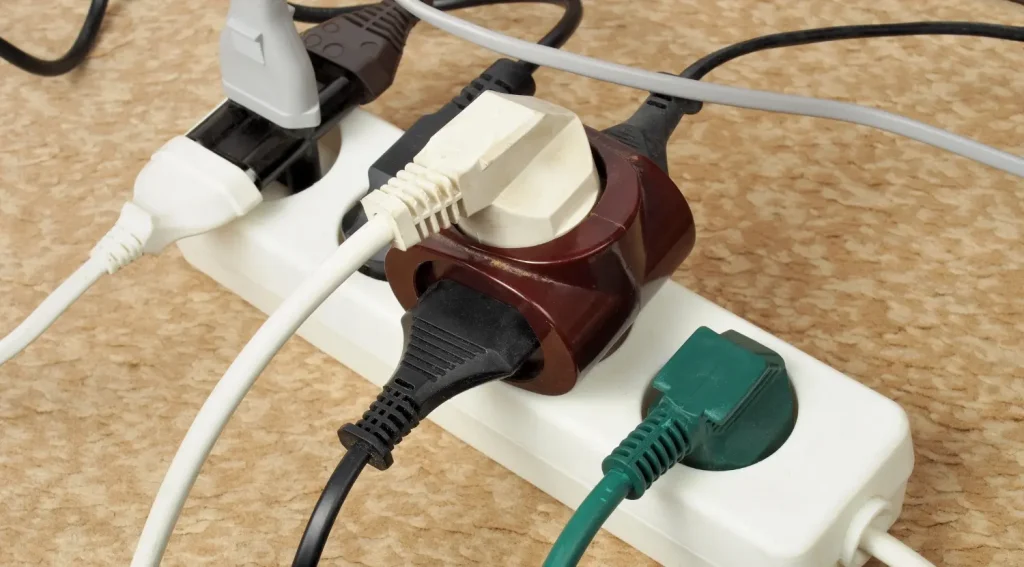
To understand the risk, we first need to talk about how an EV charges. It’s all about the difference between “peak load” and “sustained load.”
Think about a power saw or a vacuum cleaner. These tools draw a lot of power—a high peak load—but only for a few minutes at a time. Your typical household extension cord is built for exactly that: short bursts of power.
EV charging, on the contrary, is a “sustained load – especially when using any setup that may involve an extension cord for EV charger use.” This is particularly true for a Level 1 charger, the one that plugs into a standard 120V wall outlet. That charger will pull 8, 10, or even 12 amps continuously, not for minutes, but for hours. We’re talking 8, 10, or 12+ hours, depending on your battery.
A standard 14-gauge (AWG) or 16-gauge cord simply is not designed for this. It’s like asking a marathon runner to sprint the entire 26.2 miles. It just can’t cope.
1.1 The Big Risk: Heat, Meltdown, and Fire

What happens when you put a sustained load on a cord that is not built for it? Heat. A lot of heat.
This sustained 12-amp draw generates significant heat in that thin-gauge wire. At first, the cord just gets warm. Then, it gets hot to the touch. That being said, if you leave it, the plastic or rubber insulation can start to soften, then degrade, and then melt.
This is where things get truly dangerous. Once the insulation fails, you have exposed hot wires. This can lead to a short circuit, sparks, and, hence, a very real risk of fire. This fire could start at the plug, at the wall outlet (which can also overheat and melt), or anywhere along the cord itself. Oddly enough, it’s a risk many new EV owners just don’t know about.
1.2 Risk #2: Voltage Drop (The “Hidden” Problem)
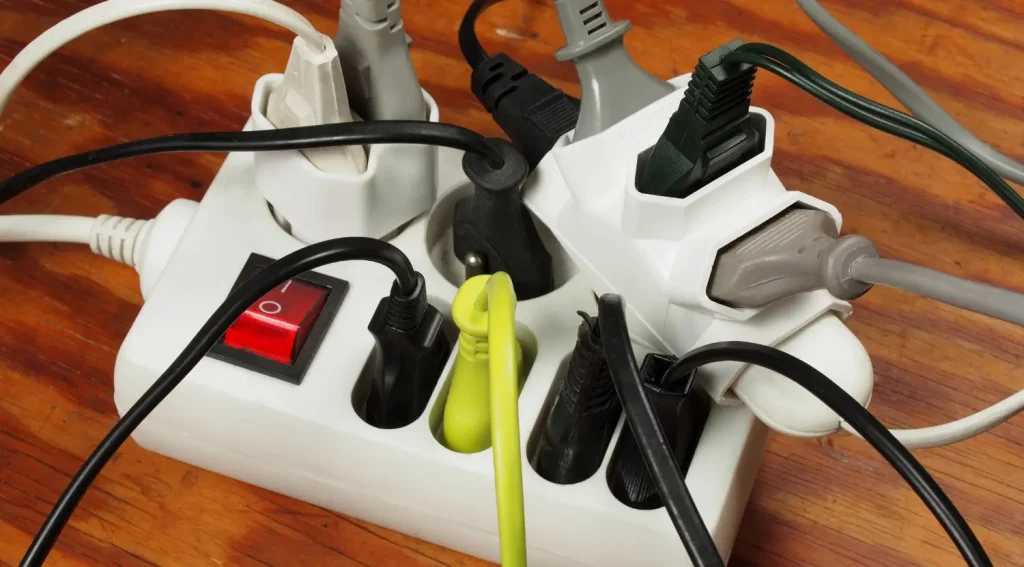
Heat is not the only issue. Thin, long cords also suffer from something called “voltage drop.”
In laymen’s term, this means that by the time the electricity travels from the wall, through 50 feet of thin wire, to your charger, it has lost some of its push.

Instead of a stable 120 volts, your charger might only be receiving 110 volts, or even less. This inefficiency means charging is slower. But on top of that, it strains your car’s expensive charging equipment.
The charger has to work harder to compensate for the poor-quality power. Over time, this could lead to premature failure of your (very expensive) charging equipment or even the car’s onboard charger.
1.3 Risk #3: Electric Shock

Let’s be honest. If you’re using an extension cord, odds are it’s running across a garage floor or driveway. A cord that has been damaged, either by overheating or just from being run over, is a severe electric shock hazard. This is doubly true if that cord is used outdoors in damp or wet conditions. Water and high-voltage electricity are a lethally bad combination.
1.4 What Your Manufacturer and Manual Say
You do not just have to take our word for it. Go ahead, check your car’s manual. Or the tag on the charging cable. In general principle, every single EV and charger manufacturer explicitly forbids using a standard extension cord.
There’s a good reason for this—they’ve tested it, and they know the risks. Having said that, if a fire or electrical fault is traced back to your use of an unapproved cord, they would arguably be well within their rights to deny a warranty claim for the damaged charging port or onboard electronics.
2. The “Emergency Only” Exception: What If You Must Use an Extension Cord?
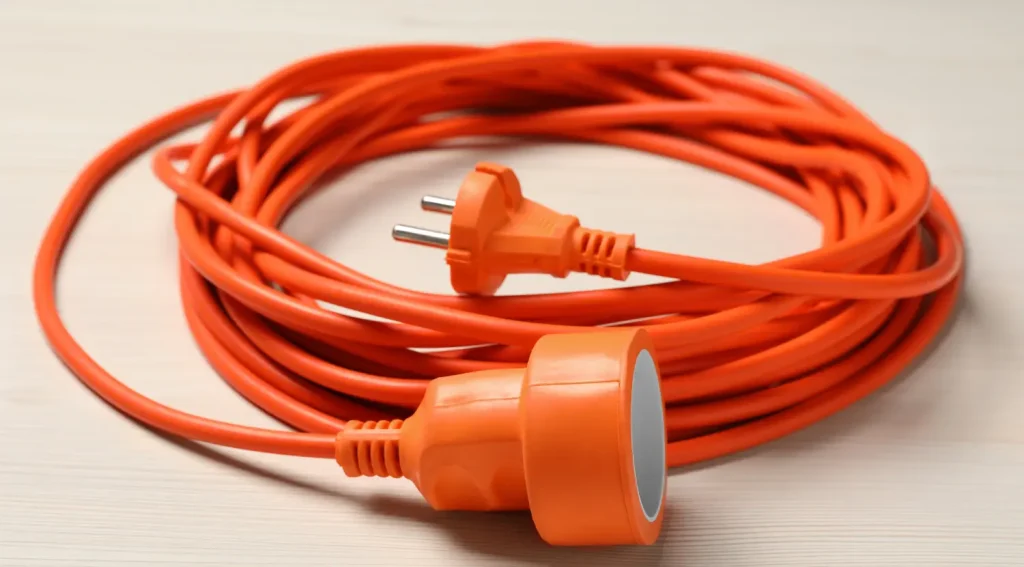
Okay, so what if you’re in a real bind? Let’s say you’re visiting a relative, you have 10% battery, and the only outlet is just out of reach. This is not for your daily charging routine, but a one-time, temporary, “last resort” solution.
In this scenario, and only in this scenario, there is a way to reduce the risk. But you cannot use a standard cord.
You must use a properly specified, heavy-duty cord-essentially an extension cord for EV charger situations that meets strict safety specifications.
Here are the exact specifications the cord must have:
1. Wire Gauge (The Most Critical Spec): This is the thickness of the actual copper wire. Remember, a lower gauge number means a thicker, safer wire.
● 12-gauge (12 AWG) is the absolute minimum for this kind of load.
● We’d say 10-gauge (10 AWG) is better still and the correct choice. It will run cooler and have less voltage drop, thereby protecting your equipment.
2. Amperage Rating: The cord must be rated for at least the amperage of your charger. For a standard 120V Level 1 charger, this means a cord rated for 15 amps, or ideally, 20 amps.
3. Length: As short as physically possible. Every extra foot adds resistance, heat, and voltage drop. 25 feet is a practical maximum. Nowhere should you be looking at a 50- or 100-foot cord for this.
4. Certification: Do not buy a cord that has not been tested by a recognized body. It must be UL-listed or ETL-listed. This certification proves it can actually handle the rating it claims.
Safe Use Checklist (If You Use the Proper Cord)
Honestly, even with the right cord, you need to be careful.
● Always fully uncoil the cord before use. A cord left coiled up traps heat and can, strangely, become a literal “inductive coil,” which creates even more heat and is a massive fire risk.
● Always plug directly into a properly grounded wall outlet. No power strips, no surge protectors, and no “daisy-chaining” (plugging one cord into another).
● Keep all connection points (the plug, the receptacle) dry and, if possible, off the ground.
● Monitor it. For the first hour of charging, and then periodically after, you need to go and physically feel the plug head and the cord. If they feel anything more than slightly warm—if they are hot—stop charging immediately.
3. The Right Way: Permanent (and Safer) Charging Solutions
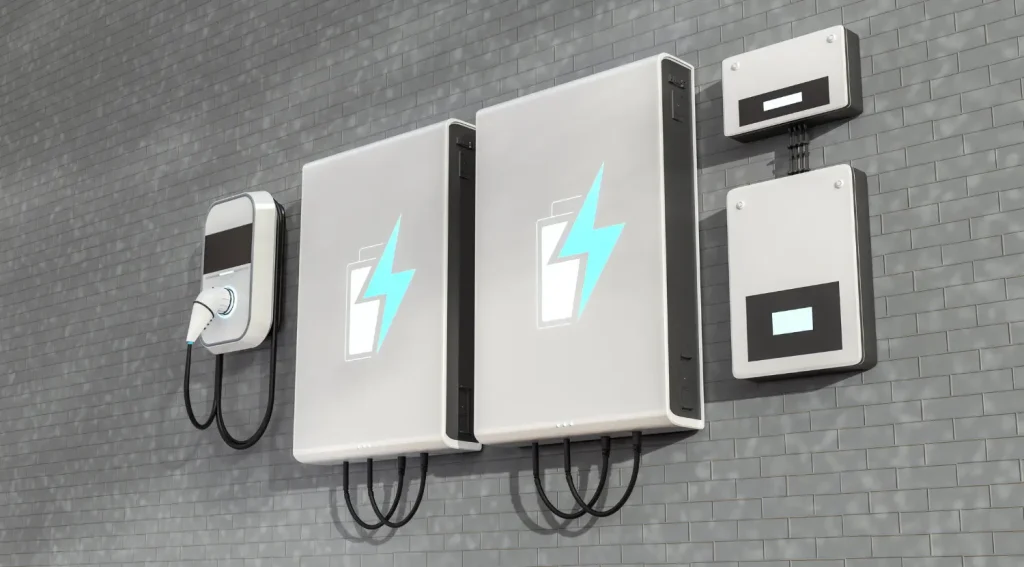
All this hassle and risk just for a temporary fix. Speaking of which, the right long-term answer is to get a proper charging setup.
You have two main options, and both are well worth the investment.
Option 1: The Dedicated Circuit (The Good Solution) For your 120V Level 1 charger, the best and safest practice is to have an electrician install a dedicated 120V outlet (NEMA 5-15 or 5-20) right where you park.
In laymen’s terms, “dedicated” means that outlet is on its own circuit breaker, and no other lights, garage door openers, or freezers are on that same circuit. This ensures the charger gets clean, stable power without the risk of overloading the circuit.
Option 2: The Level 2 Charger (The Best Solution) This is, arguably, the gold standard for home EV charging and completely removes the need for any extension cord for EV charger use. A Level 2 charger runs on 240V. It requires a new, dedicated 240V circuit run by an electrician.

The benefits are huge. In particular, it’s much, much faster. Whereas a Level 1 charger might give you 3-5 miles of range per hour, a Level 2 charger typically gives you 25-40 miles of range per hour. It’s also safer, more efficient, and what your EV was ultimately designed for.
Cost vs. Risk
Yes, these solutions cost money.
● A proper, safe, 10-gauge, 25-foot EV-rated extension cord might cost $75-$150. That’s a high price for a bad, temporary solution.
● A dedicated 120V outlet install might cost a few hundred dollars.
● A full Level 2 charger installation can range from $500 to $1,500+, depending on the charger and the complexity of the wiring.
But now, compare that cost to the cost of your homeowner’s insurance deductible after a fire. Or the cost of replacing a $2,000 onboard charger that was fried by voltage drop. You know? The math, on the whole, is quite simple.
4. In Closing
To sum up, while grabbing that old extension cord from the garage seems an easy solution, the risk of fire and damage is barely worth it. The sustained power draw of an EV is simply not what those cords are built for.
That being said, in a true, temporary bind, only a properly specified 10- or 12-gauge, UL-listed cord will do. And even then, you must be cautious and monitor it.
We advise strictly not to rely on it. Invest in a proper, dedicated charging solution, whether that’s a dedicated 120V outlet or a full Level 2 charger.
Check Duevolt’s range of Home Chargers and Portable EV Chargers, we’ve got everything for your EV needs under one-roof.
Frequently Asked Questions (FAQs)
What’s the difference between a 12-gauge and 16-gauge extension cord?
In laymen’s terms, the gauge (AWG) number is inverse to the wire’s thickness. A 16-gauge cord is thin and meant for light-duty items (like a lamp). A 12-gauge (or 10-gauge) cord is much thicker, allowing it to handle more power safely over longer periods, hence why it’s the minimum for an EV.
Can I use a heavy-duty “contractor” cord for my EV?
Perhaps, but you must check the specs. That said, just because it’s yellow and “heavy-duty” does not mean it’s correct. It must be at least 12-gauge (10-gauge is better still), rated for 15-20 amps, and be UL-listed. And speaking of length, keep it under 25 feet.
Will using the wrong extension cord void my EV’s warranty?
It probably will. In general principle, manufacturers are very clear in their manuals: do not use standard extension cords. If the cord causes a fault that damages the car’s charging port or onboard charger, they would arguably be within their rights to deny the warranty claim.
Is it safe to use an EV extension cord in the rain or snow?
We’d strongly advise you against it. Even with a proper, heavy-duty, outdoor-rated (like “SJOW”) cord, the connection points—where the plug meets the outlet and the charger—are vulnerable to moisture. Moisture and high-voltage electricity are a severe shock and fire risk. It’s well worth waiting for dry conditions or finding a protected outlet.
